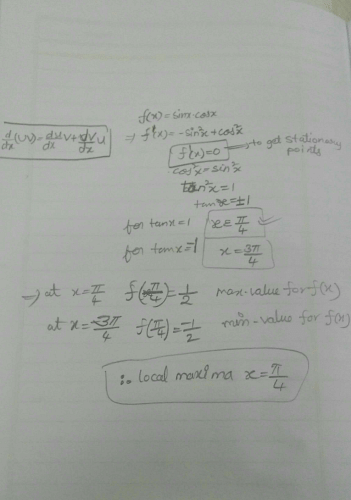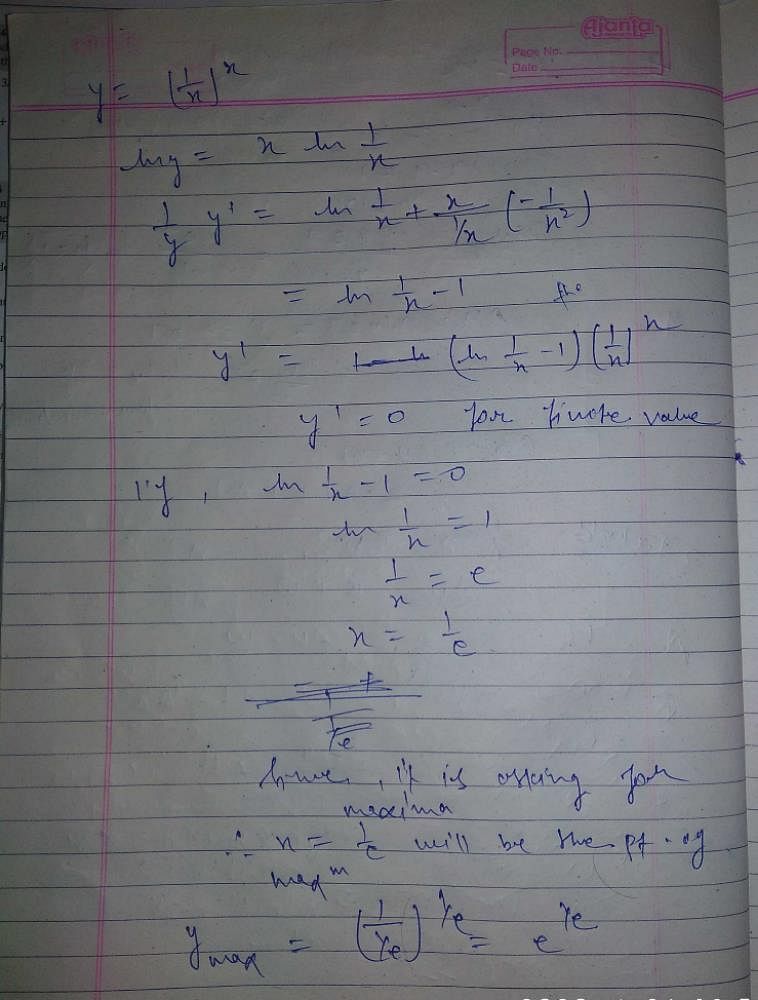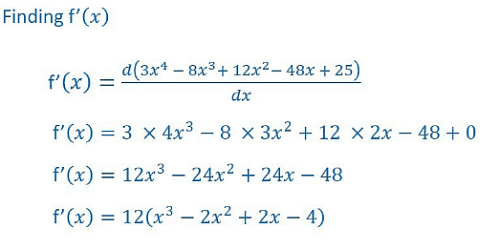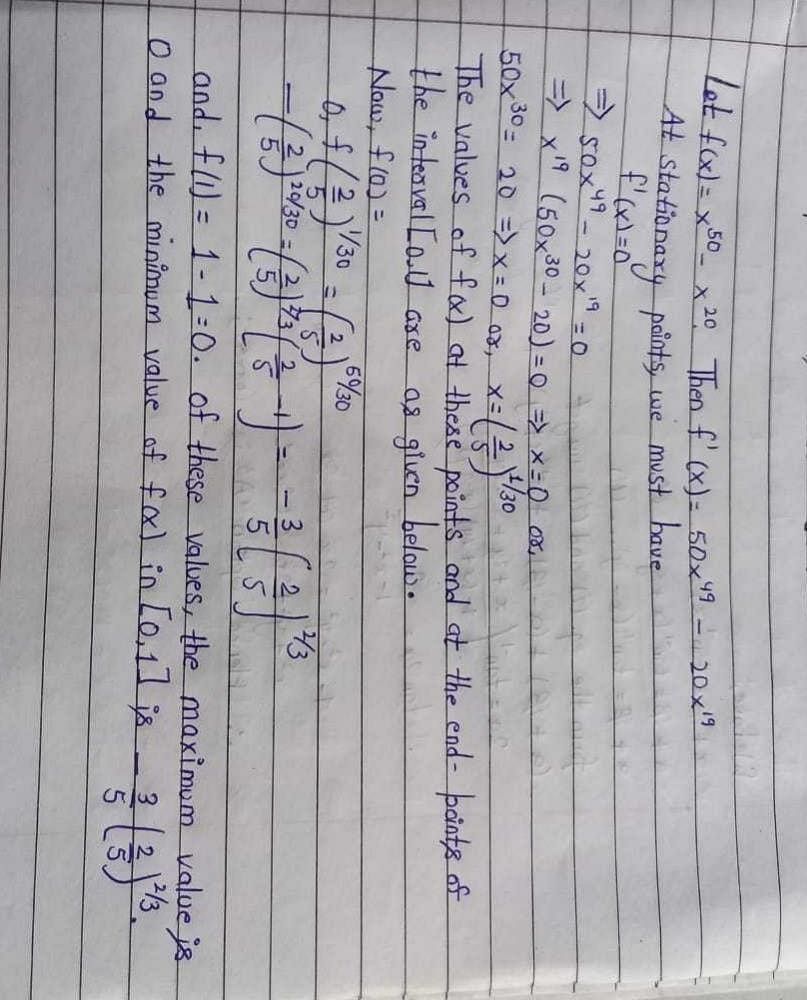All Exams >
MAT >
Calculus for MAT >
All Questions
All questions of Maxima and Minima for MAT Exam
The maximum value of f (x) = sin x in the interval [π,2π] is
a) 6
b) 0
c) -2
d) -4
Correct answer is option 'B'. Can you explain this answer?
|
|
Kiran Mehta answered |
f(x) = sin x
f’(x) =cosx
f”(x) = -sin x
f”(3pi/2) = -sin(3pi/2)
= -(-1)
=> 1 > 0 (local minima)
f(pi) = sin(pi) = 0
f(2pi) = sin(2pi) = 0
Hence, 0 is the maxima.
f’(x) =cosx
f”(x) = -sin x
f”(3pi/2) = -sin(3pi/2)
= -(-1)
=> 1 > 0 (local minima)
f(pi) = sin(pi) = 0
f(2pi) = sin(2pi) = 0
Hence, 0 is the maxima.
| 1 Crore+ students have signed up on EduRev. Have you? Download the App |
Find the maximum and minimum values of f (x) = 2x3 – 24x + 107 in the interval [1, 3].- a)89, 69
- b)89, 75
- c)59, 56
- d)89, -9
Correct answer is option 'B'. Can you explain this answer?
Find the maximum and minimum values of f (x) = 2x3 – 24x + 107 in the interval [1, 3].
a)
89, 69
b)
89, 75
c)
59, 56
d)
89, -9
|
|
Anjana Sharma answered |
Toolbox:d/dx(x^n) = nx^n−1Maxima & Minima = f′... more(x) = 0Step 1:f(x) = 2x^3−24x+107Differentiating with
Find the maximum profit that a company can make, if the profit function is given by P(x) = 41 + 24 x – 18x2- a)56
- b)49
- c)23
- d)89
Correct answer is option 'B'. Can you explain this answer?
Find the maximum profit that a company can make, if the profit function is given by P(x) = 41 + 24 x – 18x2
a)
56
b)
49
c)
23
d)
89
|
|
Aryan Khanna answered |
p’(x) = -24 - 36x
p”(x) = -36
Now, p’(x) = 0 ⇒ x = (-24)/36
x = -⅔
Also, p”(-⅔) = -36 < 0
By the second derivative test, x = -⅔
Therefore, maximum profit = p(-⅔)
= 41 - 24(-⅔) - 18(-⅔)^2
= 41 +16 - 8
⇒ 49
p”(x) = -36
Now, p’(x) = 0 ⇒ x = (-24)/36
x = -⅔
Also, p”(-⅔) = -36 < 0
By the second derivative test, x = -⅔
Therefore, maximum profit = p(-⅔)
= 41 - 24(-⅔) - 18(-⅔)^2
= 41 +16 - 8
⇒ 49
A real number x when added to its reciprocal give minimum value to the sum when x is- a)1/2
- b)-1
- c)1
- d)2
Correct answer is option 'C'. Can you explain this answer?
A real number x when added to its reciprocal give minimum value to the sum when x is
a)
1/2
b)
-1
c)
1
d)
2
|
|
Krish Das answered |
Finding the Real Number that Gives Minimum Value to the Sum
Solution:
Let x be the real number. Then, its reciprocal is 1/x.
The sum of x and its reciprocal is x + 1/x.
To find the minimum value of this sum, we can use the concept of the arithmetic mean and geometric mean inequality.
We know that for any two positive numbers a and b, the arithmetic mean is (a+b)/2 and the geometric mean is √(ab).
The arithmetic mean is always greater than or equal to the geometric mean, i.e., (a+b)/2 ≥ √(ab).
Let's apply this inequality to x and 1/x.
The arithmetic mean of x and 1/x is (x + 1/x)/2.
The geometric mean of x and 1/x is √(x * 1/x) = √1 = 1.
By the arithmetic mean and geometric mean inequality, we have:
(x + 1/x)/2 ≥ √(x * 1/x) = 1
Multiplying both sides by 2 gives:
x + 1/x ≥ 2
Therefore, the minimum value of x + 1/x is 2, which is attained when x=1.
Hence, the real number x that gives minimum value to the sum x + 1/x is 1.
Solution:
Let x be the real number. Then, its reciprocal is 1/x.
The sum of x and its reciprocal is x + 1/x.
To find the minimum value of this sum, we can use the concept of the arithmetic mean and geometric mean inequality.
We know that for any two positive numbers a and b, the arithmetic mean is (a+b)/2 and the geometric mean is √(ab).
The arithmetic mean is always greater than or equal to the geometric mean, i.e., (a+b)/2 ≥ √(ab).
Let's apply this inequality to x and 1/x.
The arithmetic mean of x and 1/x is (x + 1/x)/2.
The geometric mean of x and 1/x is √(x * 1/x) = √1 = 1.
By the arithmetic mean and geometric mean inequality, we have:
(x + 1/x)/2 ≥ √(x * 1/x) = 1
Multiplying both sides by 2 gives:
x + 1/x ≥ 2
Therefore, the minimum value of x + 1/x is 2, which is attained when x=1.
Hence, the real number x that gives minimum value to the sum x + 1/x is 1.
A point c in the domain of a function f is called a critical point of f if- a)f’ (x) = 0 at x = c
- b)f is not differentiable at x = c
- c)Either f’ (c) = 0 or f is not differentiable
- d)f” (x) = 0, at x = c
Correct answer is option 'B'. Can you explain this answer?
A point c in the domain of a function f is called a critical point of f if
a)
f’ (x) = 0 at x = c
b)
f is not differentiable at x = c
c)
Either f’ (c) = 0 or f is not differentiable
d)
f” (x) = 0, at x = c
|
|
Ishan Choudhury answered |
A point C in the domain of a function f at which either f(c) = 0 or f is not differentiable.
The point f is called the critical point.
c is called the point of local maxima
If f ′(x) changes sign from positive to negative as x increases through c, that is, if f ′(x) > 0 at every point sufficiently close to and to the left of c, and f ′(x) < 0 at every point sufficiently close to and to the right of c.
c is called the point of local minima
If f ′(x) changes sign from negative to positive as x increases through c, that is, if f ′(x) < 0 at every point sufficiently close to and to the left of c, and f ′(x) > 0 at every point sufficiently close to and to the right of c.
c is called the point of inflexion
If f ′(x) does not change sign as x increases through c, then c is neither a point of local maxima nor a point of local minima.
The point f is called the critical point.
c is called the point of local maxima
If f ′(x) changes sign from positive to negative as x increases through c, that is, if f ′(x) > 0 at every point sufficiently close to and to the left of c, and f ′(x) < 0 at every point sufficiently close to and to the right of c.
c is called the point of local minima
If f ′(x) changes sign from negative to positive as x increases through c, that is, if f ′(x) < 0 at every point sufficiently close to and to the left of c, and f ′(x) > 0 at every point sufficiently close to and to the right of c.
c is called the point of inflexion
If f ′(x) does not change sign as x increases through c, then c is neither a point of local maxima nor a point of local minima.
The maximum and minimum values of f(x) =  are
are- a)

- b)

- c)

- d)

Correct answer is option 'B'. Can you explain this answer?
The maximum and minimum values of f(x) =  are
are
a)
b)
c)
d)
|
|
Aryan Khanna answered |
f(x) = sinx + 1/2cos2x
⇒ f'(x) = cos x – sin2x
Now, f'(x) = 0 gives cosx – sin2x = 0
⇒ cos x (1 – 2 sinx) = 0
⇒ cos x = 0, (1 – 2 sinx) = 0
⇒ cos x = 0, sinx = 1/2
⇒ x = π/6 , π/2
Now, f(0) = 1/2,
f(π/6) = 1/2 + 1/4 = 3/4,
f(π/2) = 1 – 1/2 = 1/2
Therefore, the absolute max value = 3/4 and absolute min = 1/2
⇒ f'(x) = cos x – sin2x
Now, f'(x) = 0 gives cosx – sin2x = 0
⇒ cos x (1 – 2 sinx) = 0
⇒ cos x = 0, (1 – 2 sinx) = 0
⇒ cos x = 0, sinx = 1/2
⇒ x = π/6 , π/2
Now, f(0) = 1/2,
f(π/6) = 1/2 + 1/4 = 3/4,
f(π/2) = 1 – 1/2 = 1/2
Therefore, the absolute max value = 3/4 and absolute min = 1/2
Find two positive numbers x and y such that x + y = 60 and xy3 is maximum- a)x = 45, y = 15
- b)x = 15, y = 45
- c)x = 10, y = 50
- d)x = 30, y = 30
Correct answer is option 'B'. Can you explain this answer?
Find two positive numbers x and y such that x + y = 60 and xy3 is maximum
a)
x = 45, y = 15
b)
x = 15, y = 45
c)
x = 10, y = 50
d)
x = 30, y = 30
|
|
Gaurav Kumar answered |
two positive numbers x and y are such that x + y = 60.
x + y = 60
⇒ x = 60 – y ...(1)
Let P = xy3
∴ P =(60 – y)y3 = 60y3 – y4
Differentiating both sides with respect to y, we get

For maximum or minimum dP/dy = 0
⇒ 180y2 - 4y3 = 0
⇒ 4y2 (45 - y) = 0
⇒ y = 0 or 45 - y = 0
⇒ y = 0 or y = 45
⇒ y = 45 (∵ y = 0 is not possible)


Thus, the two positive numbers are 15 and 45.
x + y = 60
⇒ x = 60 – y ...(1)
Let P = xy3
∴ P =(60 – y)y3 = 60y3 – y4
Differentiating both sides with respect to y, we get

For maximum or minimum dP/dy = 0
⇒ 180y2 - 4y3 = 0
⇒ 4y2 (45 - y) = 0
⇒ y = 0 or 45 - y = 0
⇒ y = 0 or y = 45
⇒ y = 45 (∵ y = 0 is not possible)


Thus, the two positive numbers are 15 and 45.
The function f(x) = log x- a)Has a local maximum but no local minimum value
- b)Has both ,a local minimum and a local maximum value
- c)Has neither a local minimum nor a local maximum value
- d)Has a local minimum but no local maximum value
Correct answer is option 'C'. Can you explain this answer?
The function f(x) = log x
a)
Has a local maximum but no local minimum value
b)
Has both ,a local minimum and a local maximum value
c)
Has neither a local minimum nor a local maximum value
d)
Has a local minimum but no local maximum value
|
|
Alok Mehta answered |
The domain is (0,∞).
Logarithm of zero is not defined. Any number raised to any power can’t be zero.
Logarithm of negative numbers is also not defined. The natural logarithm function ln(x) is defined only for x>0. The complex logarithmic function Log(z) is defined for negative values.
f(x) = x5 – 5x4 + 5x3 – 1. The local maxima of the function f(x) is at x =- a)1
- b)5
- c)0
- d)3
Correct answer is option 'A'. Can you explain this answer?
f(x) = x5 – 5x4 + 5x3 – 1. The local maxima of the function f(x) is at x =
a)
1
b)
5
c)
0
d)
3
|
|
Rajat Patel answered |
f′(x)=5x4−20x3+15x2
f′(x)=5x2(x2−4x+3)
when f′(x)=0
⇒5x2(x2−4x+3)=0
⇒5x2(x−3)(x−1)=0
⇒x=0,x=3,x=1
Find the points of local maxima or minima for the function f(x) = x3.ex.- a)x=-3 is a point of local maxima
- b)x=-3 is a point of local minima
- c)x=0 is a point of local maxima
- d)x=0 is a point of local minima
Correct answer is option 'B'. Can you explain this answer?
Find the points of local maxima or minima for the function f(x) = x3.ex.
a)
x=-3 is a point of local maxima
b)
x=-3 is a point of local minima
c)
x=0 is a point of local maxima
d)
x=0 is a point of local minima
|
|
Gitanjali Tiwari answered |
Solution:
The given function is f(x) = x3.ex.
To find the points of local maxima or minima, we need to find the critical points of the function.
Critical points: The points where the derivative of the function is either zero or does not exist.
f'(x) = 3x2.ex + x3.ex
Let f'(x) = 0, then
3x2.ex + x3.ex = 0
x2(ex + x) = 0
x = 0 or x = -ex
Now, we need to check the nature of critical points using the second derivative test.
f''(x) = 6x.ex + 6x2.ex + 2x3.ex
At x = 0,
f''(0) = 0
Thus, x = 0 is not a point of local maxima or minima.
At x = -ex,
f''(-ex) = 6(-ex).ex + 6(-ex)2.ex + 2(-ex)3.ex
f''(-ex) = -2ex3 < />
Thus, x = -ex is a point of local maxima.
Hence, option B is the correct answer.
Note: The second derivative test is used to determine the nature of critical points. If f''(x) > 0, then the critical point is a point of local minima. If f''(x) < 0,="" then="" the="" critical="" point="" is="" a="" point="" of="" local="" maxima.="" if="" f''(x)="0," then="" the="" test="" is="" inconclusive.="" 0,="" then="" the="" critical="" point="" is="" a="" point="" of="" local="" maxima.="" if="" f''(x)="0," then="" the="" test="" is="" />
The given function is f(x) = x3.ex.
To find the points of local maxima or minima, we need to find the critical points of the function.
Critical points: The points where the derivative of the function is either zero or does not exist.
f'(x) = 3x2.ex + x3.ex
Let f'(x) = 0, then
3x2.ex + x3.ex = 0
x2(ex + x) = 0
x = 0 or x = -ex
Now, we need to check the nature of critical points using the second derivative test.
f''(x) = 6x.ex + 6x2.ex + 2x3.ex
At x = 0,
f''(0) = 0
Thus, x = 0 is not a point of local maxima or minima.
At x = -ex,
f''(-ex) = 6(-ex).ex + 6(-ex)2.ex + 2(-ex)3.ex
f''(-ex) = -2ex3 < />
Thus, x = -ex is a point of local maxima.
Hence, option B is the correct answer.
Note: The second derivative test is used to determine the nature of critical points. If f''(x) > 0, then the critical point is a point of local minima. If f''(x) < 0,="" then="" the="" critical="" point="" is="" a="" point="" of="" local="" maxima.="" if="" f''(x)="0," then="" the="" test="" is="" inconclusive.="" 0,="" then="" the="" critical="" point="" is="" a="" point="" of="" local="" maxima.="" if="" f''(x)="0," then="" the="" test="" is="" />
The sum of two positive numbers is 20. Find the numbers if their product is maximum- a)5,15
- b)8,12
- c)20,0
- d)10,10
Correct answer is option 'D'. Can you explain this answer?
The sum of two positive numbers is 20. Find the numbers if their product is maximum
a)
5,15
b)
8,12
c)
20,0
d)
10,10
|
|
Meera Nambiar answered |
Given:
The sum of two positive numbers is 20.
To find:
The numbers if their product is maximum.
Approach:
To find the numbers, we need to maximize their product while satisfying the condition that their sum is 20. We can solve this problem by using the concept of the arithmetic mean-geometric mean inequality.
The arithmetic mean-geometric mean inequality states that for any two positive numbers, their arithmetic mean is always greater than or equal to their geometric mean. Mathematically, it can be expressed as:
AM ≥ GM
Where AM denotes the arithmetic mean and GM denotes the geometric mean.
Solution:
Let's consider the two positive numbers as 'a' and 'b'.
1. Consider the case of a = 5 and b = 15:
- Sum of the numbers: 5 + 15 = 20
- Product of the numbers: 5 * 15 = 75
2. Consider the case of a = 8 and b = 12:
- Sum of the numbers: 8 + 12 = 20
- Product of the numbers: 8 * 12 = 96
3. Consider the case of a = 20 and b = 0:
- Sum of the numbers: 20 + 0 = 20
- Product of the numbers: 20 * 0 = 0
4. Consider the case of a = 10 and b = 10:
- Sum of the numbers: 10 + 10 = 20
- Product of the numbers: 10 * 10 = 100
Conclusion:
From the above calculations, we can see that the product of the numbers is maximum when a = 10 and b = 10. Therefore, the correct answer is option 'D'.
The sum of two positive numbers is 20.
To find:
The numbers if their product is maximum.
Approach:
To find the numbers, we need to maximize their product while satisfying the condition that their sum is 20. We can solve this problem by using the concept of the arithmetic mean-geometric mean inequality.
The arithmetic mean-geometric mean inequality states that for any two positive numbers, their arithmetic mean is always greater than or equal to their geometric mean. Mathematically, it can be expressed as:
AM ≥ GM
Where AM denotes the arithmetic mean and GM denotes the geometric mean.
Solution:
Let's consider the two positive numbers as 'a' and 'b'.
1. Consider the case of a = 5 and b = 15:
- Sum of the numbers: 5 + 15 = 20
- Product of the numbers: 5 * 15 = 75
2. Consider the case of a = 8 and b = 12:
- Sum of the numbers: 8 + 12 = 20
- Product of the numbers: 8 * 12 = 96
3. Consider the case of a = 20 and b = 0:
- Sum of the numbers: 20 + 0 = 20
- Product of the numbers: 20 * 0 = 0
4. Consider the case of a = 10 and b = 10:
- Sum of the numbers: 10 + 10 = 20
- Product of the numbers: 10 * 10 = 100
Conclusion:
From the above calculations, we can see that the product of the numbers is maximum when a = 10 and b = 10. Therefore, the correct answer is option 'D'.
How many units should be sold so that a company can make maximum profit if the profit function for x units is given by p(x) = 25 + 64x - x2- a)16 units
- b)32 units
- c)8 units
- d)64 units
Correct answer is option 'B'. Can you explain this answer?
How many units should be sold so that a company can make maximum profit if the profit function for x units is given by p(x) = 25 + 64x - x2
a)
16 units
b)
32 units
c)
8 units
d)
64 units
|
|
Shounak Datta answered |
Solution:
To find the maximum profit, we need to differentiate the profit function with respect to x and equate it to zero.
p(x) = 25x - 64x^2 + x^2
p'(x) = 25 - 128x + 2x
Setting p'(x) = 0, we get
2x - 128x + 25 = 0
Simplifying the above equation, we get
x = 16 units or 8 units
We need to check which of the above values of x gives us the maximum profit. To do this, we can differentiate the profit function twice and check the sign of the second derivative.
p''(x) = -128 + 2 = -126
Since p''(x) is negative, we can conclude that x = 16 units gives us the maximum profit.
Therefore, the correct answer is option B, 32 units.
To find the maximum profit, we need to differentiate the profit function with respect to x and equate it to zero.
p(x) = 25x - 64x^2 + x^2
p'(x) = 25 - 128x + 2x
Setting p'(x) = 0, we get
2x - 128x + 25 = 0
Simplifying the above equation, we get
x = 16 units or 8 units
We need to check which of the above values of x gives us the maximum profit. To do this, we can differentiate the profit function twice and check the sign of the second derivative.
p''(x) = -128 + 2 = -126
Since p''(x) is negative, we can conclude that x = 16 units gives us the maximum profit.
Therefore, the correct answer is option B, 32 units.
Find the point of local maxima or minima for the function 
- a)X=-7
- b)X=49
- c)X=0
- d)X=7
Correct answer is option 'D'. Can you explain this answer?
Find the point of local maxima or minima for the function

a)
X=-7
b)
X=49
c)
X=0
d)
X=7

|
Astha Gupta answered |
Calculate f'(x) ( derivative) of the function and equate it zero , solve the equation you will get values where x will be Maxima or minima
Chapter doubts & questions for Maxima and Minima - Calculus for MAT 2024 is part of MAT exam preparation. The chapters have been prepared according to the MAT exam syllabus. The Chapter doubts & questions, notes, tests & MCQs are made for MAT 2024 Exam. Find important definitions, questions, notes, meanings, examples, exercises, MCQs and online tests here.
Chapter doubts & questions of Maxima and Minima - Calculus for MAT in English & Hindi are available as part of MAT exam.
Download more important topics, notes, lectures and mock test series for MAT Exam by signing up for free.
Calculus for MAT
11 videos|16 docs|4 tests
|
Signup to see your scores go up within 7 days!
Study with 1000+ FREE Docs, Videos & Tests
10M+ students study on EduRev
|
Free Exam Preparation
at your Fingertips!
Access Free Study Material - Test Series, Structured Courses, Free Videos & Study Notes and Prepare for Your Exam With Ease

 Join the 10M+ students on EduRev
Join the 10M+ students on EduRev
|

|
Forgot Password
OR
Signup to see your scores
go up within 7 days!
Access 1000+ FREE Docs, Videos and Tests
Takes less than 10 seconds to signup
















